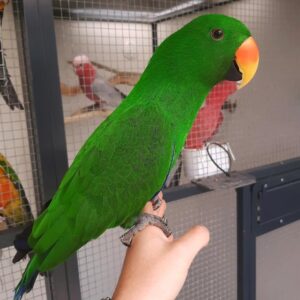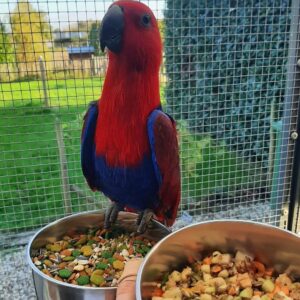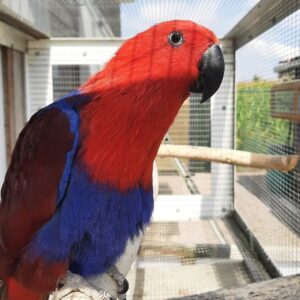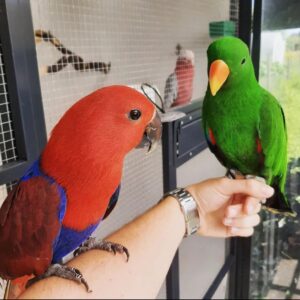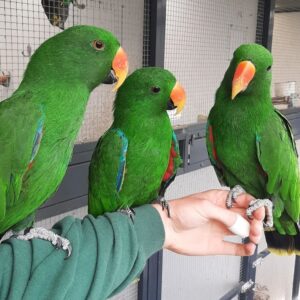Eclectus Parrots For Sale
Eclectus parrots live in tropical rainforests and originated in the Solomon Islands. Wild populations also live in northeastern Australia, Indonesian, the Moluccas, and New Guinea. Its name “eclectus” is derived from the word “eclectic” since the male and female species look so different. Buy Eclectus parrots
In their native monsoon forests, eclectus nest high up in the trees. They usually manage to find a deep nest hole in a tree where they can lay their eggs and raise a family. Eclectus parrots for sale UK
Charming, eye-catching, and intelligent, eclectus parrots are captivating birds that make impressive pets. Their beautiful colors, talking ability, and lovable personalities have established this bird as one of the most popular pet parrots. This bird is one of the larger parrot species, and it does require the right owner with plenty of time and space to house this bird.
Temperament
The eclectus is a very friendly and intelligent bird species described as gentle, tranquil, and caring. Eclectus parrots are also affectionate. Most thrive best when socialization is part of their daily routine.1 They cherish the time they spend interacting with their families. They are also sensitive and can quickly become stressed if they feel neglected.
This bird will learn the routine and what to expect in your household. They enjoy the comings and goings, as well as being a part of it.
Around 18 months of age, the birds begin to reach sexual maturity. Sometimes this brings with it some aggression or the instinct to “feed” whatever is nearby. You may notice some naughty nipping behavior. This period is called bluffing, and it is best to ignore it and turn to distraction techniques instead of reinforcing it. With time, they pass through the phase and learn what’s acceptable. .
While both the males and females of the species make lovely pets, many owners claim that males tend to be a bit more trainable and agreeable. On the flip side, females may be less dependent on their owners and tend to handle stress better. Females may also be bossier and more aggressive than a male, particularly during breeding. Even in captivity, a female’s nesting instincts remain strong. You might find her trying to nest in secluded areas of your home.
Speech and Vocalizations
Eclectus parrots join Amazons and African greys as being one of the best species for training to speak. They are quick to learn almost anything you want to teach them. Many people find them to be on the quieter side when compared to other parrots. They have a distinctive honk and other vocalizations that can be amusing the first few times, but loud and startling.
Eclectus Parrot Colors and Markings
Eclectus are known as sexually dimorphic, meaning that you can tell the sex of the bird by its physical characteristics. Male eclectus birds are a brilliant emerald green color with bright orange beaks and splashes of red and blue under their wings. By contrast, the females are mostly bright red with black beaks and deep purple markings on their chests and tails. Before the early 20th century, since the male and female birds looked so different, they were thought to be entirely two different species.
Instead of distinct lines found on many bird’s feathers, eclectus feathers seem to blend. Their coloring makes for brilliant camouflage in their native habitat; you can often hear them before you can see them.
Caring for an Eclectus Parrot
Most eclectus birds can live in a multiple bird household, but some have jealous tendencies. Make sure to give an eclectus your undivided time and attention when introducing it or any new bird or your aviary.
An eclectus lives best in an aviary—11 feet long by 3 foot wide and 7 feet high— especially if you keep a pair. These birds like to fly, climb, and stay busy. If you do not have room for an aviary, then make sure the cage you provide is at the minimum 2 feet long by 3 feet wide and 4 feet tall.
Common Health Problems
An eclectus is unique in that it sometimes exhibits toe-tapping and wing-flipping. This behavior is similar to feather plucking, which is a common issue with parrots that feel neglected. However, when all three of these actions occur in an eclectus, it can be a sign of a severe health issue. Nutritional deficiencies caused by excess vitamins and minerals (like vitamin A), fortified foods, or artificial ingredients as well as eating foreign objects like beads, or stress are probable causes. It’s vital to see an avian vet right away.
Other health conditions that an eclectus is prone to getting include:
- Avian polyomavirus, an infection that causes skin tumors
- Constricted toe syndrome, a condition that causes circulation to be cut off to the bird’s toe
- Psittacine beak and feather disease, a viral immune system disease

